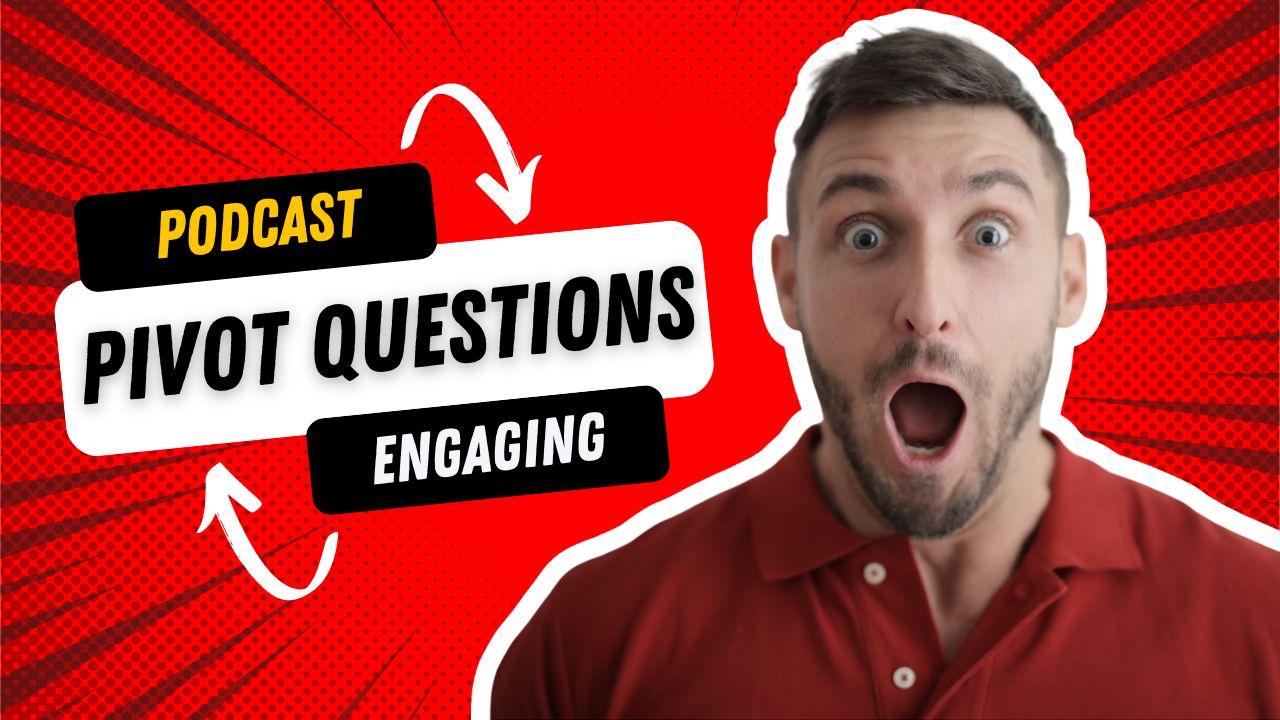Ever find yourself stuck in a conversation that feels like it’s going nowhere? As a podcast host or guest, you can’t afford to let this happen – your audience expects engaging and dynamic discussions. That’s why pivot questions are an essential tool in your podcasting arsenal. In this post, we’ll dive into the importance of pivot questions and how they can take your podcast from dull to delightful.
While it is important to perfect your Interviewing skills, pivot questions are an essential tool in any podcaster’s toolkit. With a little practice, you’ll be able to keep your audience engaged and on the edge of their seats – and that’s a winning strategy for any successful podcast!
Meaning and importance of pivoting the conversation:
Pivoting the conversation means shifting the topic of discussion in a new direction. It’s like a sudden change in direction on a basketball court, but for conversations!
Pivoting is important in podcasting because it helps keep the conversation fresh, interesting, and engaging for your listeners.
By changing the topic or direction of the discussion, you can uncover new insights, explore new perspectives, and keep your audience on the edge of their seats. So the next time you’re in a conversation that’s losing steam, try a pivot question and see where it takes you!
Techniques To Pivot The Conversation:
To pivot the conversation into another direction in a podcast, there are several techniques that you can use as a host:
- Use a transition: One of the easiest ways to pivot a conversation is to use a transition phrase that connects the previous topic to the new one. For example, you could say “Speaking of [new topic],” or “That reminds me of something related to [new topic].”
- Ask an open-ended question: Asking an open-ended question is a great way to introduce a new topic while still keeping the conversation flowing. For example, you could say, “That’s really interesting, can you tell me more about [new topic]?”
- Acknowledge the current topic: If you want to pivot the conversation, it’s important to acknowledge the current topic and let the guest know that you’re shifting gears. You could say something like, “That’s a great point, and I want to shift the conversation slightly to talk about [new topic].”
- Use a personal anecdote: Sharing a personal story or anecdote is a great way to transition the conversation to a new topic. You could say something like, “Your point reminds me of something that happened to me recently related to [new topic].”
- Be prepared: If you anticipate wanting to pivot the conversation in a particular direction, it can be helpful to prepare some questions or topics in advance that you can use as a guide to steer the conversation.
Remember, it’s important to pivot the conversation in a way that feels natural and keeps the flow of the podcast going. Don’t be afraid to experiment with different techniques until you find what works best for you and your guests.
Transition Questions:
Here are some examples of questions that you can use to pivot the conversation in another direction during a podcast:
- I’m curious to know more about [related topic]. How do you see [original topic] intersecting with [related topic]?
- That’s really interesting. Can you tell us more about [specific detail or example related to the current topic] and how it connects to [related topic]?
- We’ve talked a lot about [original topic]. I’m interested to hear your thoughts on [completely new topic]. What do you think about that?
- Let’s switch gears for a moment. I’d like to hear about your experience with [completely new topic]. How did you get started with that?
- This is all really insightful. Can you share some of your knowledge and experience with [related but different topic]?
- Before we move on, I’m curious to know more about [specific point related to original topic] and how that ties into [completely new topic].
- It seems like [original topic] and [related topic] have some overlap. How do you think we can learn from [related topic] and apply those insights to [original topic]?
Remember, the key to pivoting the conversation is to find a natural connection between the original topic and the new direction you want to take the conversation. You want to make sure that the new topic is relevant to the conversation and that your guest is interested and knowledgeable about it. By doing so, you can keep the conversation flowing and uncover new insights that your audience will find valuable.
Open-ended pivot questions:
Here are some open-ended questions that you can use to pivot the conversation in a podcast:
- What inspired you to get into [topic]?
- Can you tell us about a time when you faced a challenge related to [topic] and how you overcame it?
- How do you see [topic] evolving in the future?
- What do you think is the biggest misconception people have about [topic]?
- Can you share an example of a successful project or experience you’ve had related to [topic]?
- How does [topic] intersect with or relate to other areas of your life or work?
- What do you find most interesting or exciting about [topic]?
- Can you speak to any current trends or developments related to [topic]?
- What advice would you give to someone just starting out in [topic]?
- How has your perspective on [topic] changed over time?
The key to pivoting the conversation when using open-ended questions is that, they allow your guest to share their thoughts and insights. These questions should encourage your guest to expand on their ideas and provide a platform for deeper discussion.
Closed-ended Pivot Questions:
While open-ended questions are generally better for pivoting the conversation in a podcast, there are certain situations where closed-ended questions can be useful for getting more specific answers or clarifying a point. Here are some examples of closed-ended questions you can use to pivot the conversation:
- Do you think [topic] is more important for [specific group] or [specific group]?
- Would you say that [specific aspect of topic] is a challenge for most people in [related industry]?
- How do you think [specific event or trend] has impacted [topic]?
- Have you noticed any changes in [specific aspect of topic] over the past few years?
- Can you give me an example of a time when [specific issue related to topic] came up in your work or personal life?
- Is there a particular strategy or approach you recommend for [specific goal related to topic]?
- How do you measure success in [specific aspect of topic]?
- Have you seen any notable success stories in [specific area of topic] recently?
Remember, closed-ended questions should be used sparingly, and only when you need more specific information or clarification on a particular point. They should be followed up with open-ended questions to keep the conversation flowing and encourage further discussion.
Tips and best practices:
Here are some best practices and tips to keep in mind when pivoting the conversation in a podcast:
- Listen actively: Pivoting the conversation can be tricky, so it’s important to actively listen to your guest’s responses to make sure you’re able to find a natural connection between the current topic and the new direction you want to take the conversation.
- Be flexible: While it’s important to have a plan for your podcast, it’s also important to be flexible and willing to pivot the conversation if the opportunity arises.
- Provide context: When pivoting the conversation, it’s important to provide context to your audience so they understand why you’re making the shift and how the new topic relates to the original discussion.
- Find a natural connection: Look for a natural connection between the current topic and the new direction you want to take the conversation. This will help make the transition smoother and keep the conversation flowing.
- Use open-ended questions: Use open-ended questions to explore the new topic and encourage your guest to share their thoughts and experiences.
- Keep it relevant: Make sure the new topic is relevant to the overall theme of your podcast and that your guest is interested and knowledgeable about it.
- Summarize and bridge: After pivoting the conversation, summarize what was just discussed and bridge the new topic back to the original conversation to help tie everything together.
Real World Examples Of Successful Pivots:
Here are a few real world examples of podcasts that successfully pivoted the conversation:
- “Reply All” – In the episode “Long Distance”, the hosts set out to investigate a phone scam but end up uncovering a much larger and more interesting story. By pivoting the conversation, the hosts were able to take the podcast in a completely unexpected direction, resulting in one of their most popular and well-received episodes.
- “The Daily” – In an episode about the 2020 Democratic primary, the host pivots the conversation to discuss the impact of the COVID-19 pandemic on the election. By making this pivot, the podcast was able to provide timely and relevant information that was of great interest to listeners.
- “Revisionist History” – In the episode “The Basement Tapes”, the host begins by discussing the life and work of a little-known musician, but then pivots to explore larger themes of creativity, success, and the pursuit of excellence. By making this pivot, the podcast was able to deliver a thought-provoking and engaging episode that resonated with listeners.
In each of these examples, the pivot was successful because it added depth, interest, and relevance to the discussion. By pivoting the conversation, the podcasts were able to uncover new insights, explore new perspectives, and keep their listeners engaged and interested.
Conclusion
In conclusion, pivoting the conversation in a podcast can be a powerful tool for keeping your content fresh, interesting, and engaging for your listeners. By asking the right pivot questions, you can uncover new insights, explore new perspectives, and keep your audience on the edge of their seats. Remember to keep your goals in mind and be flexible in your approach.
Whether you already started or looking to start your own podcast, consider signing up for an incubation program that will guide you step by step in building and growing your show. With expert guidance and support, you can develop the skills and knowledge you need to succeed in podcasting. So don’t be afraid to take the leap and try something new – the world of podcasting is waiting for you!






0 Comments